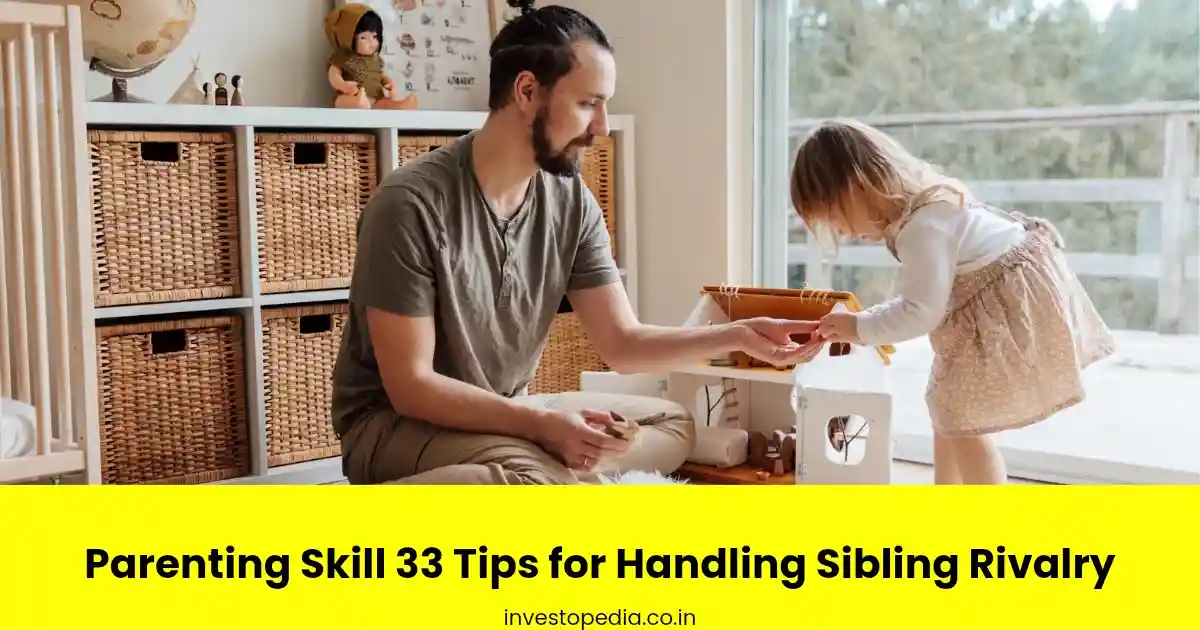|
Getting your Trinity Audio player ready... |
Introduction
Parenting, they say, is the most rewarding job in the world. Yet, it doesn’t come with a manual. As parents, we often find ourselves caught in the whirlwind of sibling rivalry, desperately seeking a lifebuoy to navigate these stormy waters. Fear not, for in this article, we unveil the secret arsenal of Parenting Skill: 33 Tips for Handling Sibling Rivalry. Brace yourselves as we embark on a journey through the heart of family dynamics, exploring creative and effective ways to foster understanding, love, and harmony among siblings.
Understanding the Battlefield: Sibling Rivalry Unveiled
Ah, sibling rivalry! It’s as old as time itself, and every parent has faced it. But fear not, for understanding is the first step toward resolution. Here’s a glimpse into the battlefield:
What Triggers Sibling Rivalry?
- Limited Resources: Whether it’s parental attention, toys, or space, scarcity often sparks competition.
- Comparison: Children are often compared, fueling feelings of inadequacy and jealousy.
- Age and Developmental Differences: Variations in age and maturity levels can create misunderstandings and clashes.
- Seeking Identity: Siblings might compete to establish their unique identity within the family.
- Attention-Seeking Behavior: Rivalry can be a way for children to seek attention, even if it’s negative.
33 Tips for Smoothing the Waters
1. Foster Individuality:
Encourage each child’s unique talents and interests, celebrating what makes them special.
2. Shared Activities:
Promote bonding through activities they both enjoy, like board games or arts and crafts.
3. Effective Communication:
Teach them to express feelings constructively, avoiding hurtful language.
4. Model Conflict Resolution:
Show them how to resolve conflicts peacefully, becoming a living example of understanding.
5. Praise and Encouragement:
Acknowledge their achievements individually, boosting their self-esteem.
6. Avoid Comparison:
Resist the temptation to compare them; each child is a unique individual.
7. Set Realistic Expectations:
Recognize their abilities and limitations, setting achievable goals.
8. Family Meetings:
Hold regular family meetings, giving everyone a platform to express their feelings.
9. Teach Empathy:
Help them understand each other’s feelings and perspectives, nurturing empathy.
10. Create a Safe Space:
Establish zones where each child can have personal time without intrusion.
11. Encourage Teamwork:
Assign tasks that require collaboration, emphasizing the importance of working together as a team.
12. Promote Problem-Solving:
Guide them in resolving disputes independently, teaching them essential conflict resolution skills.
13. Teach Respect for Differences:
Celebrate differences, whether in interests, abilities, or opinions, fostering respect for each other’s uniqueness.
14. Time Alone with Each Child:
Spend quality time with each child individually, reinforcing your bond and making them feel special.
15. Be Mindful of Birth Order:
Understand the impact of birth order on their personalities and dynamics, tailoring your approach accordingly.
16. Encourage Apologies and Forgiveness:
Teach them the importance of apologizing when wrong and forgiving each other genuinely.
17. Create a Sibling Support System:
Help them see each other as allies, nurturing a sense of camaraderie rather than competition.
18. Incorporate Humor:
Use humor to diffuse tense situations, making them realize that conflicts can be resolved with laughter.
19. Limit Screen Time:
Regulate screen time, encouraging them to engage in more interactive, face-to-face activities.
20. Acknowledge and Address Jealousy:
If jealousy arises, acknowledge it. Validate their feelings and guide them on how to cope constructively.
21. Encourage Gratitude Journals:
Have them maintain gratitude journals, appreciating the positive aspects of having each other as siblings.
22. Sibling Mentoring:
Foster mentoring relationships, where the older sibling helps the younger one, promoting cooperation and understanding.
23. Create a Conflict Resolution Chart:
Develop a chart where they can visually see their conflicts being resolved, reinforcing the idea that disagreements can be resolved amicably.
24. Promote Acts of Kindness:
Encourage them to perform random acts of kindness for each other, nurturing a culture of care and consideration.
25. Teach Emotional Regulation:
Guide them in managing their emotions, preventing outbursts and encouraging healthy expression of feelings.
26. Family Traditions:
Create traditions that involve the whole family, reinforcing a sense of unity and belonging.
27. Outdoor Activities:
Engage in outdoor activities as a family, allowing them to bond over shared experiences and adventures.
28. Regular Check-Ins:
Have regular one-on-one check-ins with each child, giving them a safe space to express their feelings and concerns.
29. Encourage Sibling Projects:
Support collaborative projects, channeling their energy into creative ventures that strengthen their bond.
30. Parental Modeling:
Show them how you resolve conflicts with your partner or other family members, demonstrating healthy communication and compromise.
31. Counseling or Therapy:
If sibling rivalry persists and escalates into damaging behavior, consider professional counseling or therapy. A neutral third party can help mediate and provide coping strategies.
32. Celebrate Achievements Together:
When one child accomplishes something, celebrate it as a family. This cultivates a sense of shared pride and mutual support.
33. Teach Conflict as a Learning Opportunity:
Instead of viewing conflicts as negative, teach your children that disagreements can be opportunities to learn about each other and grow stronger together.
FAQs: Demystifying Sibling Rivalry
Q1: Is Sibling Rivalry Normal?
A1: Absolutely! It’s a natural part of growing up and learning social skills. However, addressing it constructively is key.
Q2: Can Parents Play Favorites Unintentionally?
A2: Yes, even unintentional favoritism can trigger rivalry. Be mindful of your actions and words.
Q3: What If Sibling Rivalry Becomes Aggressive?
A3: Address it immediately. Teach them that violence is never an answer and seek professional help if needed.
Q4: Should I Punish Sibling Rivalry?
A4: Focus on teaching, not punishing. Encourage positive behavior and discourage negative actions.
Real-Life Stories: Triumph Over Rivalry
The Johnsons: A Tale of Sibling Harmony
Meet the Johnsons, a family of four. Sarah, the elder sister, and Alex, the younger brother, were once embroiled in constant battles for attention and toys. Their parents, recognizing the need for change, employed the Parenting Skill: 33 Tips for Handling Sibling Rivalry.
- Fostered Bonding: By engaging them in shared hobbies, the siblings developed mutual interests, fostering a deeper bond.
- Effective Communication: The parents taught them to express their feelings, reducing misunderstandings and conflicts.
- Celebrated Individuality: Sarah’s love for painting and Alex’s knack for puzzles were celebrated, boosting their self-esteem.
Today, the Johnsons stand as a testament to the power of understanding and effective parenting techniques.
Real-Life Stories: Embracing Sibling Harmony
The Parkers: Turning Rivalry into Lifelong Friendship
The Parker siblings, Emily and Ethan, once engaged in fierce battles over toys and attention. Their parents, determined to foster a lifelong bond, employed the Parenting Skill: 33 Tips for Handling Sibling Rivalry.
- Promoted Independence: By encouraging individual hobbies, they developed self-confidence, reducing the need for constant comparison.
- Taught Empathy: Empathy was instilled in their hearts, allowing them to understand each other’s feelings and perspectives.
- Cultivated Gratitude: They were taught to appreciate the value of having a sibling, transforming jealousy into gratitude.
Now adults, Emily and Ethan share an unbreakable bond, proving that with the right approach, sibling rivalry can indeed blossom into lifelong friendship.
Real-Life Stories: Sibling Bonds that Overcame Challenges
The Cartwrights: From Foes to Friends
The Cartwright siblings, Olivia and Jake, were once bitter rivals. Every day seemed like a battle for dominance until their parents decided to apply the Parenting Skill: 33 Tips for Handling Sibling Rivalry.
- Encouraged Open Communication: Olivia and Jake were encouraged to express their feelings openly, fostering understanding between them.
- Promoted Shared Responsibilities: They were assigned joint responsibilities, teaching them cooperation and teamwork.
- Celebrated Small Victories: Even minor achievements were celebrated, reinforcing positive behavior and diminishing jealousy.
Now, Olivia and Jake stand as confidants and supporters in each other’s lives, proving that with patience and the right techniques, sibling rivalry can indeed transform into lifelong camaraderie.
Conclusion: Nurturing Sibling Bonds
Parenting isn’t a perfect science, but with the right tools, it becomes an art. Embracing the Parenting Skill: 33 Tips for Handling Sibling Rivalry equips you with the brushes and colors to paint a harmonious picture of sibling relationships. Remember, each child is a unique masterpiece, deserving love, attention, and understanding. As you navigate the intricate tapestry of sibling dynamics, armed with these tips and a heart full of love, you can transform rivalry into camaraderie, creating a nurturing environment where every child can blossom. Here’s to the power of parenting and the unbreakable bonds of family!
This post is for informational purposes only.Invest responsibly.No guarantees of results. Seek professional guidance before investing.Consult experts for personalized advice.AI-assisted content, editorially reviewed.See our terms for details.Please note that I am not a SEBI registered investment advisor. The information provided in this article is for informational and educational purposes only and should not be construed as financial advice. Always consult with a qualified and SEBI registered financial professional before making any investment decisions. .Follows Google policies.Not affiliated with Investopedia.com. investopedia.co.in Independent site.







